Body mandala practice in Vajrayana Tantric Buddhism — and riding the winds of the inner body \”Where mind goes, the body follows\”
“Where the mind goes, the body follows” is an ancient unattributed wisdom saying — although it is credited to Arnold Schwarzenegger in modern times. Arnie was probably paraphrasing a quote often attributed to Zhang San Feng, the Taoist monk who developed the martial art Tai Chi:
“The chi flows where the mind goes.” Martial artists understand this concept immediately. You want to break a board, think through the board. Bodybuilders like Arnie, “think through the pain.” Tai Chi, an inner body-oriented, martial art is almost entirely focused on the concept of “chi flow where the mind goes.”

This modern quote from Arnold Schwarzenegger is proably paraphrased from the ancient Tai Chi saying.
Contents of Feature (click to navigate)
Mandala — the Universe in a word
Mandala is a Sanskrit word that literally means “circle,” but is a symbol representing the “universe.” In one sense, you could say body mandala brings the entire universe (mandala) within our bodies. In the case of divine mandalas, where the energies of the universe are represented as deity forms, we bring that form within. And, of course, “where the mind goes, the body follows” — in other words, though it’s a visualization, we literally are working with those energies at some level.
In Tantric Buddhism, when we visualize a “seed syllable” of an Enlightened deity at our heart chakra, we are working with the most basic of body mandalas: usually a syllable on a lotus at our heart.
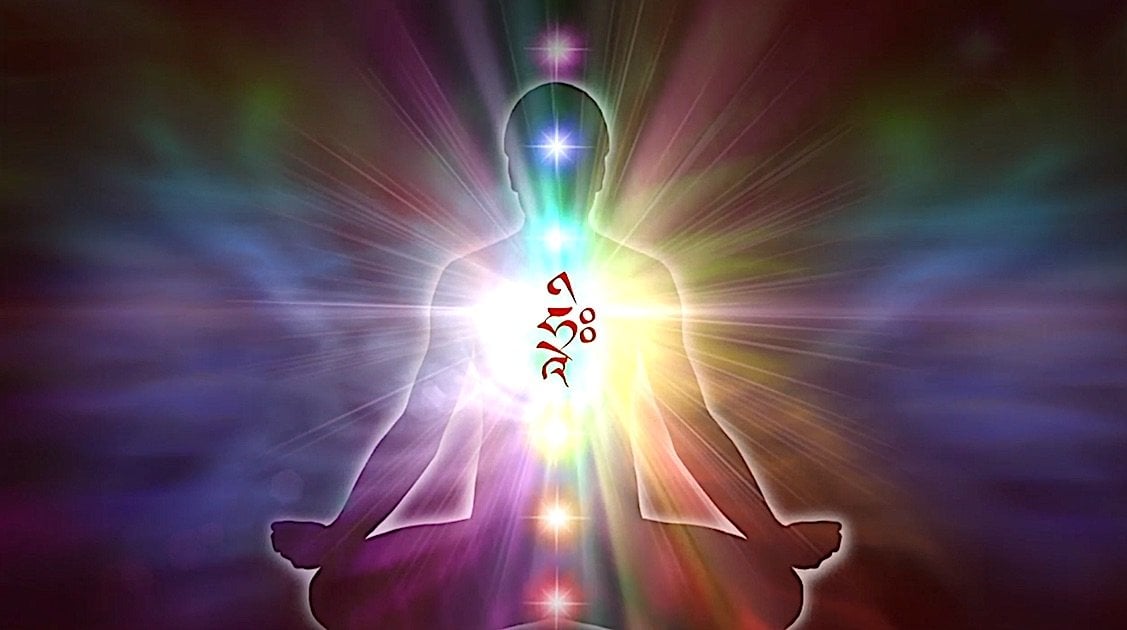
In the most basic of “body mandalas” you visualize your own body as hollow, the nature of divine light, and in the centre of your chest you visualize the HRI seed syllable. The HRI syllable symbolizes your consciousness.
Once mastered, body mandala — not to be confused with other mandalas such as sand and outer deity mandalas — is the most profound and effective of Tantric techniques. Given the importance of “mind” in Buddhism, this should not be surprising. Advanced body mandalas, where the energies of many Enlightened deities are visualized in a mandala in the inner body, are the most profound of practices.
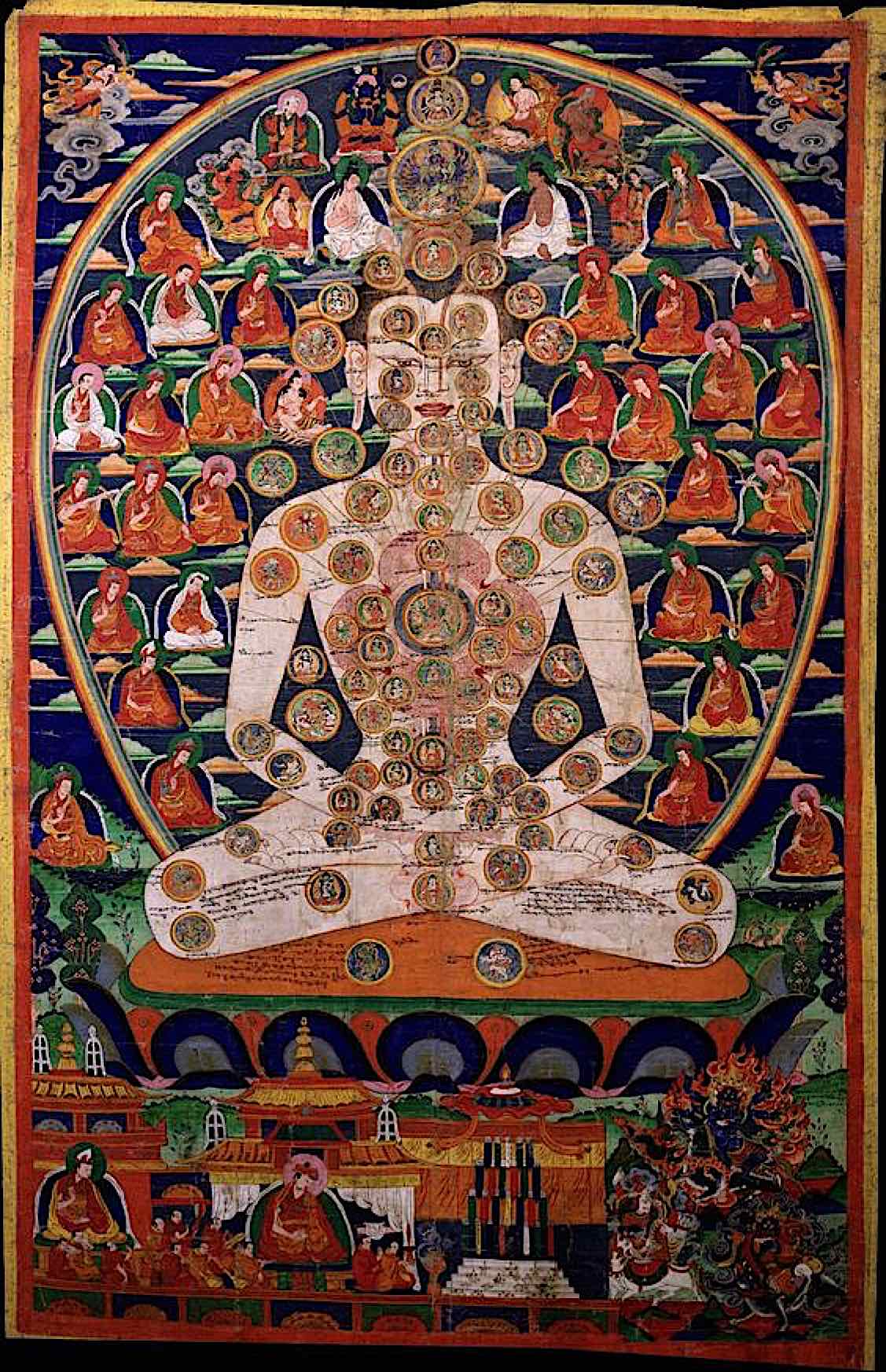
A more complex body mandala, requiring teacher and empowerment to practice.
Physiology of mind/body flow
The concept of “where the mind goes, the body follows,” certainly is well founded and proven in various meditation and pain studies. Physiologically, the vagus nerve is a factor: when the mind focuses on calmness, the body calms (and vice versa, interestingly.)
Here are some various stories on verifiable research on mind/body and meditation:
In mindfulness, it is easy to demonstrate: by focusing the mind on the ear sense, we can suddenly hear sounds that we couldn’t previously discern. In Tantra and “Eastern” Medicine, both of which work with the “subtle” body, the effect is more complex. And, in Tantric Buddhist Body Mandala meditation, this saying takes on a profound direction. [For a feature story on the Vagus Nerve in meditation, see>>]
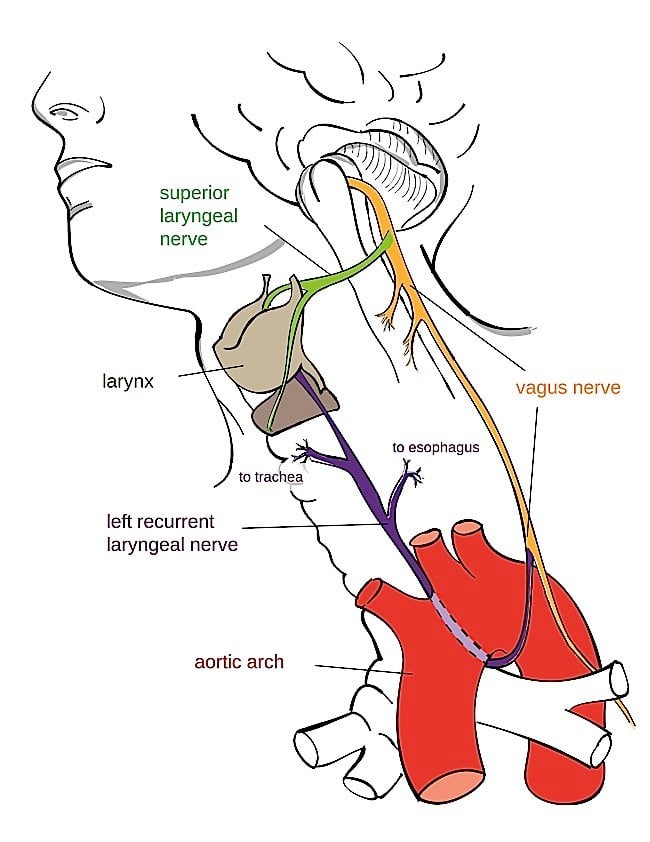
The Vagus Nerve helps the body regulate stress responses, among other major functions, and is the mechanism by which we can positively influence our health and bodies with meditation.
Chi or La goes where you think
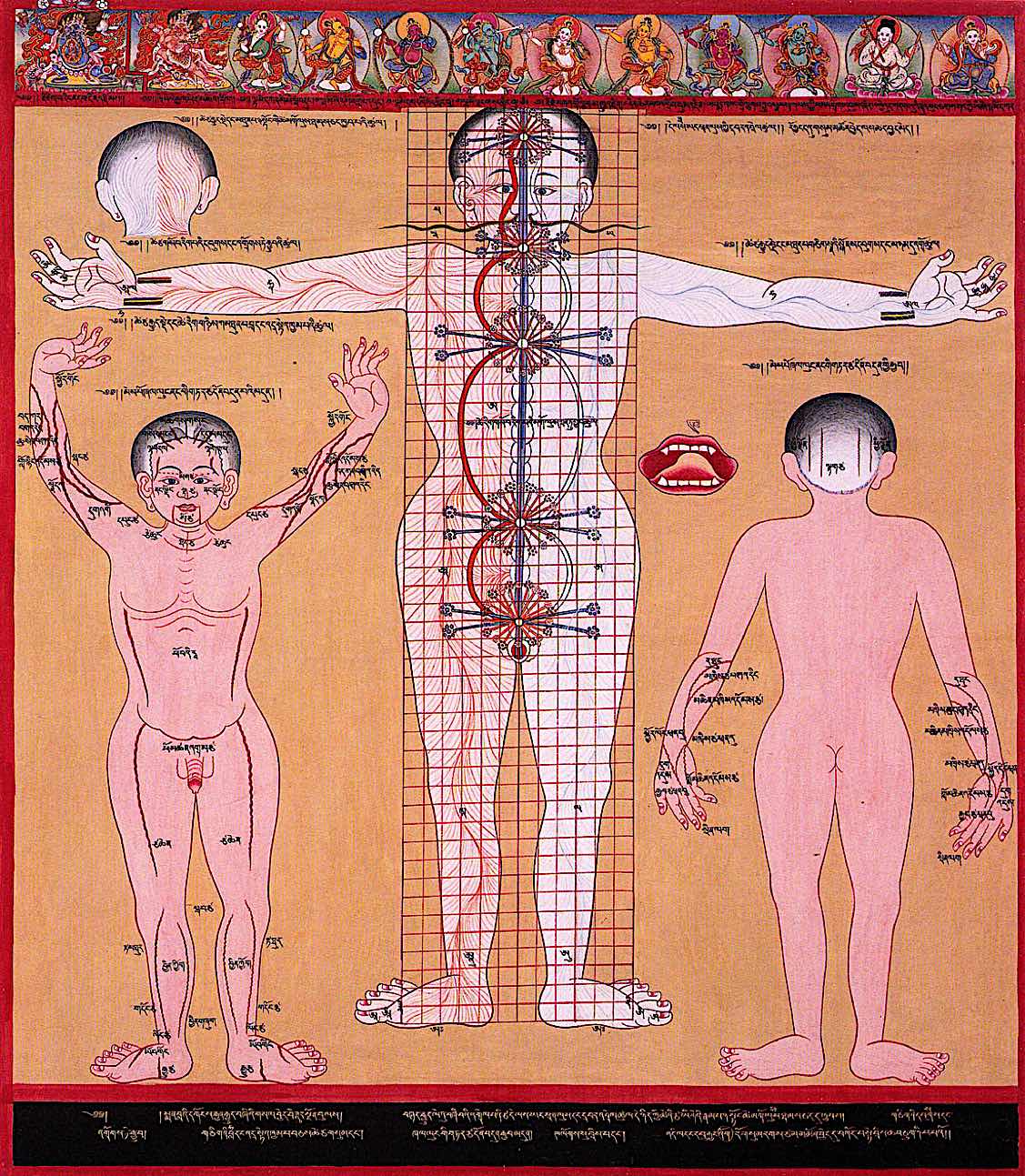
Old Tibetan medicine drawings illustrating the subtle body, including the chakras and channels. Chi or La energy flows through the channels, meridians and chakras of the subtle body.
“The chi flows where the mind goes is an extremely simple description of how your attention focuses your life energy,” explained Paull Crouse, in a fascinating feature on Tai Chi. “Where you focus your life energy is what you create in your life. This is a fundamental idea for living your life with energetic awareness. How you think is reflected by how you live your life.
“If you focus your attention on the idea that your life is screwed up, then your life is screwed up. If you focus your attention on the idea that you are strong, intelligent and capable of overcoming the challenges in your life — then that is what you are.
If you constantly focus your attention on the TV set, then you are living your life watching TV. (I’ll give you a hint: you weren’t put on this planet to watch TV all day).”
Body Mandala is an inner body meditation, just like Tai Chi — except now the focus is on the divine Enlightened presence of meditational deities. There can be no doubt that bringing the mind to the divine is a better use of time than watching TV.

Tai Chi is an “internal” martial art that focuses on energy from within. Chi (inner energy, La in Tibetan) is part of the name, emphasizing its importance.
Bringing the divine within with Body Mandala
By meditating on inner body, and bringing divine Enlightened presence (deities) to the subtle body, we not only purify ourselves — which has healing and karmic effects — we also can find the fast path to Enlightenment. While other inner body meditations focus on energies (Tai Chi, Chigong, Tantric completion practices, acupuncture) Body Mandala actually focuses on bringing the Enlightened Buddhas energy within.
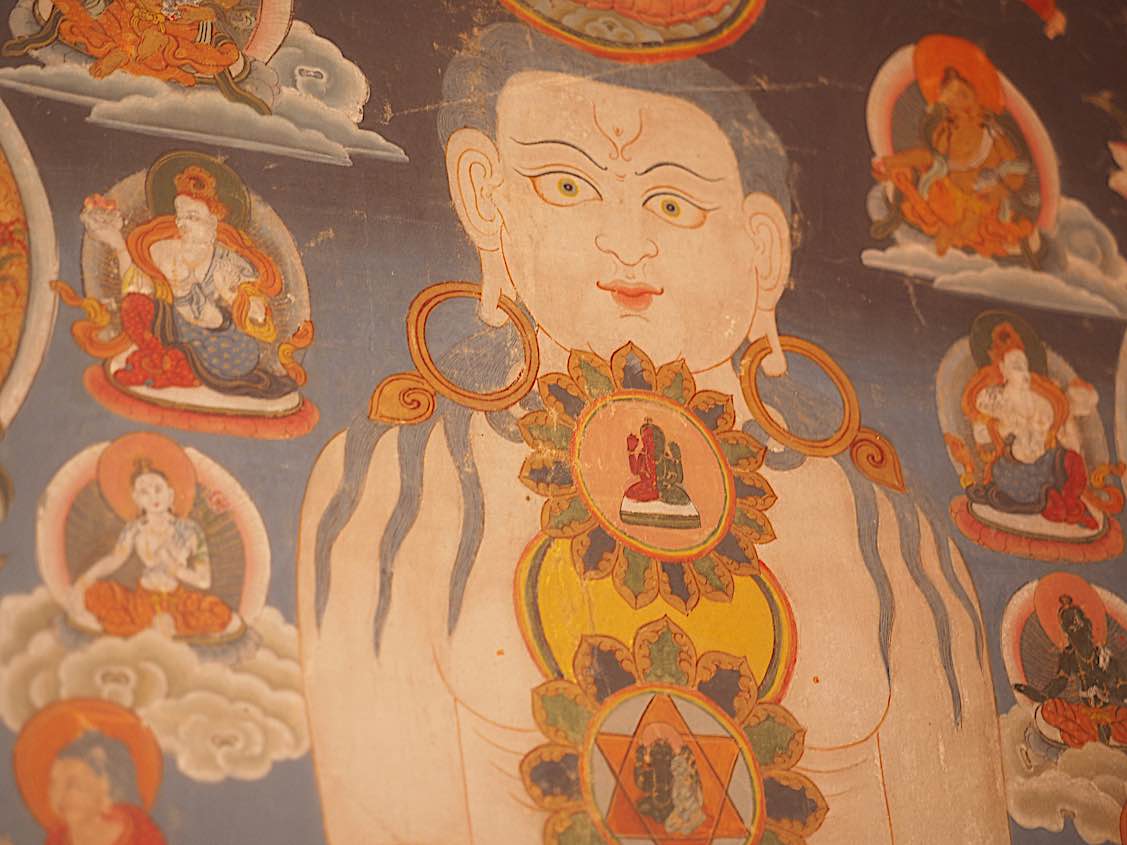
A body mandala from a Tangkha acquired from a San Francisco museum. It is most likely a body mandala in the Bon tradition.
Mandalas (and their more two-dimensional symbols, yantras) represent, in this case, the divine universe of the deity energy we are working with. For example, Amitabha’s mandala works with the energies of compassion and method. This is a common concept, for example, with Hinduism (and Hermeticism, as discussed below) here explained by Madhu Khanna:
“Because of the relationship that exists in the Tantras between the outer world (the macrocosm) and man’s inner world (the microcosm), every symbol in a yantra is ambivalently resonant in inner-outer synthesis, and is associated with the subtle body and aspects of human consciousness.” [4]
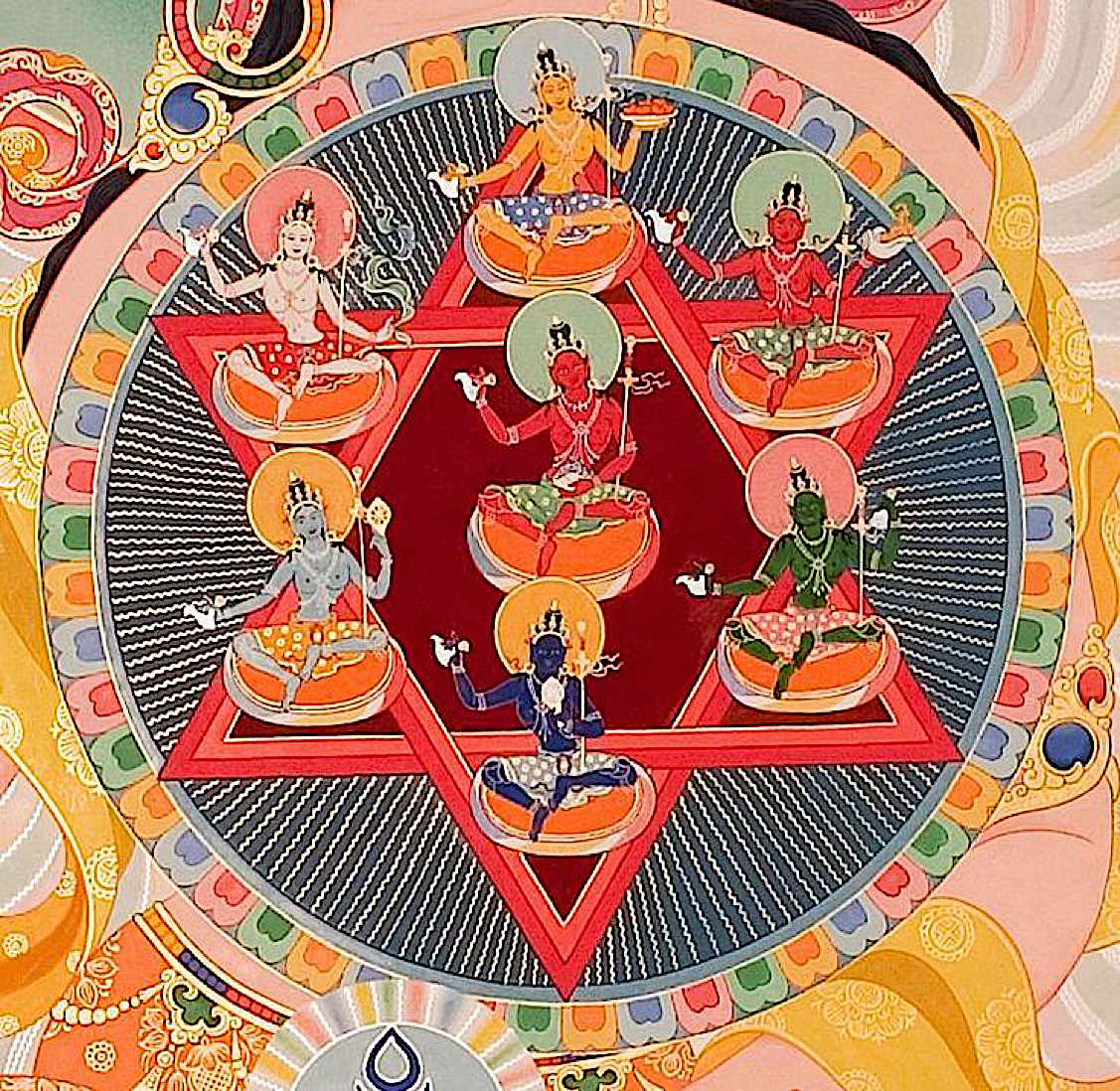
A mandala of Dakinis visualized in the body.
Most Body Mandalas are Higher Yoga practices
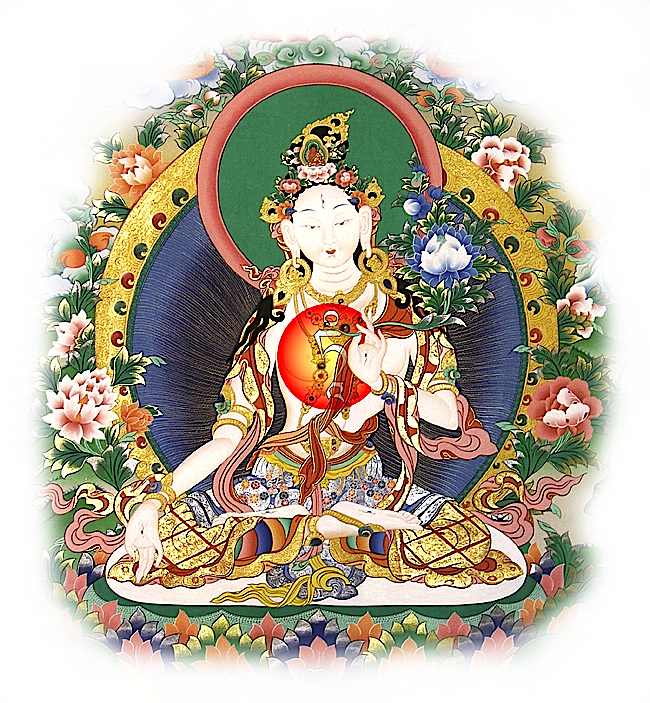
White Tara visualized here with a white TAM seed syllable at her heart. TAM is the seed syllable of all Taras, who are all Tara. Typically Green Tara is visualized as a green Tam, and White Tara as a white syllable. The seed syllable contains the essence not only of the mantra, but also Tara Herself.
Usually, these practices are Higher Yogic practices in Tantric Buddhism — in the major Anuttarayoga systems such as the Chakrasamvara, Vajrayogini, and Guhyasamaja. These require teachers and empowerment.
However, some more basic visualizations do include, for example, seed syllables at the heart chakra — which is the most simple of Body Mandalas. A seed syllable, or heart-essence, is, in fact, the deity as the unborn natural sound of dharmata, the nature of reality, which is great emptiness, free from dualism.
By visualizing a HRI (for Amitabha, Chenrezig or Hayagriva) or a BAM (Vajrayogini) or TAM (Tara) at the heart chakra, we bring the divine blessings within. More complex body mandalas, the ones that require empowerments and teachers, do the same thing, but with more profound effect.
This depends, of course, on our own karmic dispositions: including our habits (do we practice hard), our conduct (karma) and the quality of our visualizations and training. Ripening our good karma, and purifying our bad karma, is one of the goals of Body Mandala practice (and all deity practice).
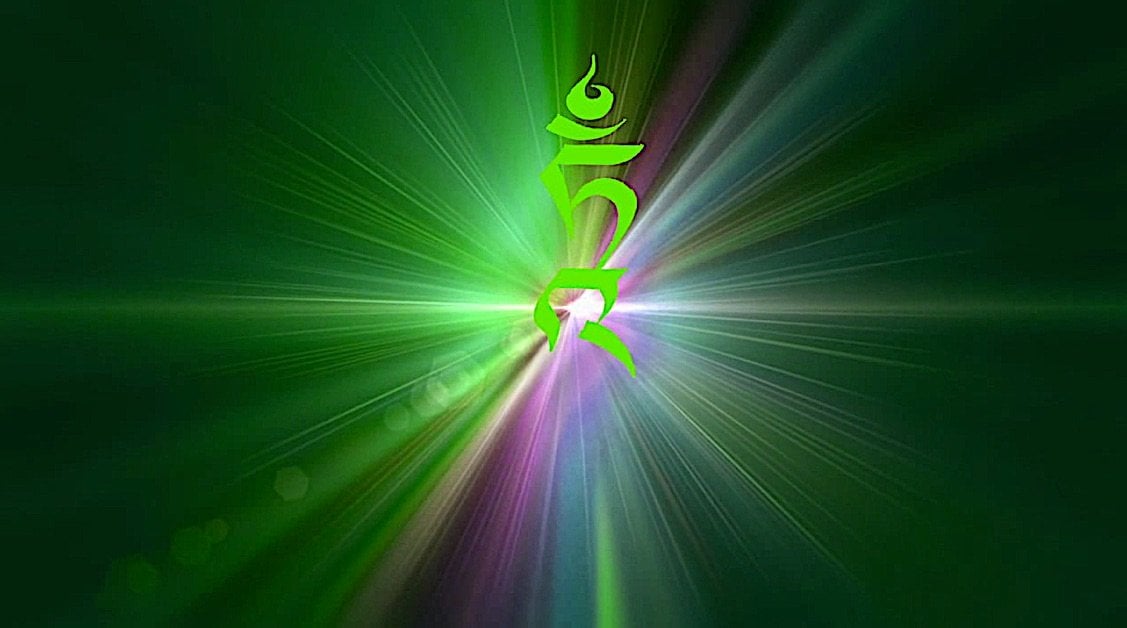
A beautiful seed syllable, made up of light at the heart chakra. This is the TAM seed syllable of Green Tara. A seed syllable is the essence of the Enlightened Being.
Riding the winds: La or Chi is the Mind’s “horse”
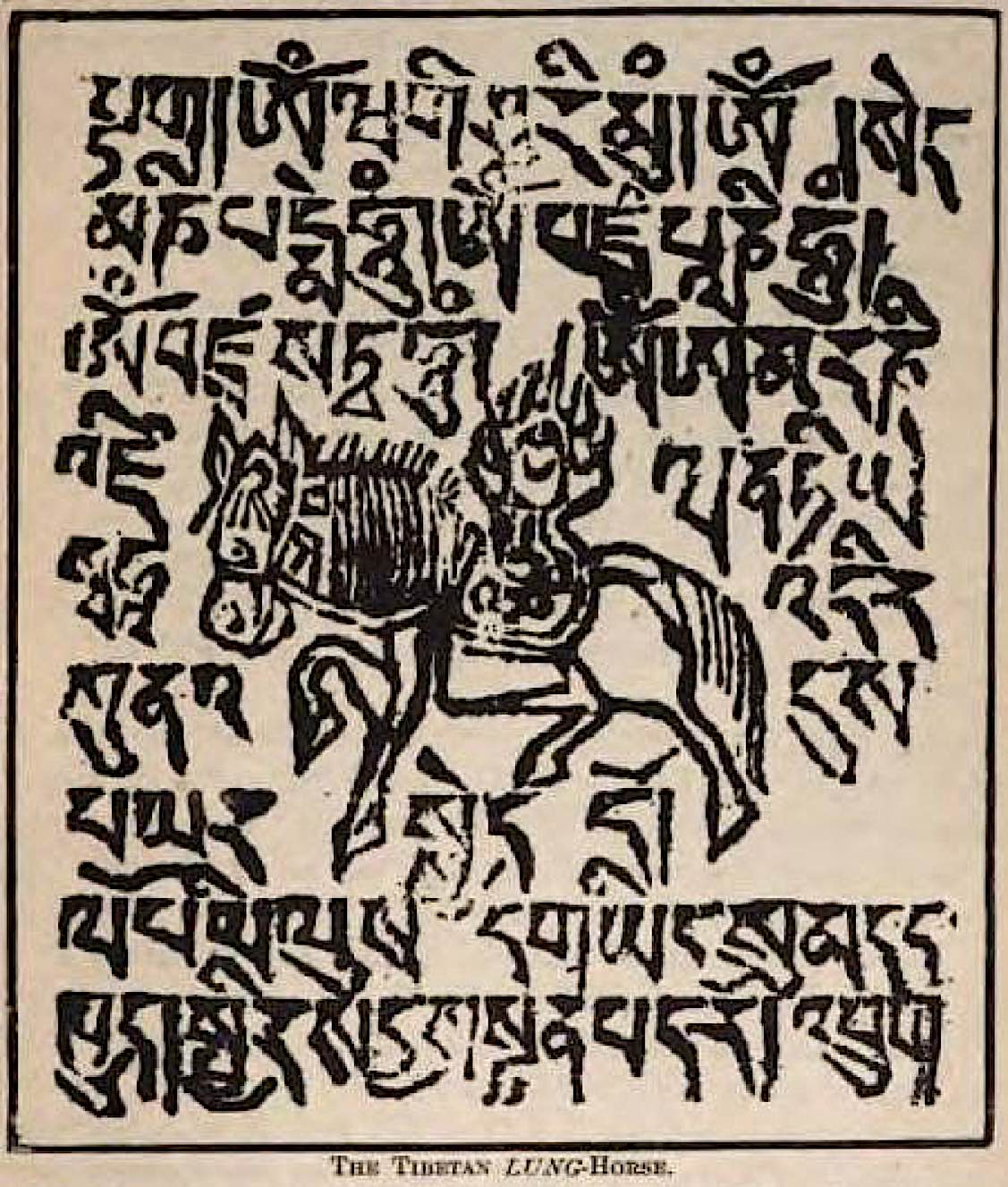 In Completion Practices in Tantra, the mind seeks to actually “ride the winds” (inner energy, chi, la) of the channels and chakras of the inner body, with the lofty goal of attaining (ultimately) Enlightenment. The metaphor most often used is wind-horse (Tibetan Lung-ta). In this visualization, La or Chi is wind or inner energy, and the mind travels the channels, meridians and chakras on this wind. On Wikipedia, wind-horse is equated with “soul” — but this is an eastern shamanic tradition. In Tantric Buddhism, where the concept of soul is not endorsed, the same language more correctly describes our subtle consciousness riding La. Rather than “soul” it is our subtle consciousness, riding the vitality of life force. In Tantra, when we speak of “increasing wind horse” it means to increase our vital inner energy. “Decline of wind horse” means the opposite. [3]
In Completion Practices in Tantra, the mind seeks to actually “ride the winds” (inner energy, chi, la) of the channels and chakras of the inner body, with the lofty goal of attaining (ultimately) Enlightenment. The metaphor most often used is wind-horse (Tibetan Lung-ta). In this visualization, La or Chi is wind or inner energy, and the mind travels the channels, meridians and chakras on this wind. On Wikipedia, wind-horse is equated with “soul” — but this is an eastern shamanic tradition. In Tantric Buddhism, where the concept of soul is not endorsed, the same language more correctly describes our subtle consciousness riding La. Rather than “soul” it is our subtle consciousness, riding the vitality of life force. In Tantra, when we speak of “increasing wind horse” it means to increase our vital inner energy. “Decline of wind horse” means the opposite. [3]
Interestingly, this same icon, the wind-horse, is used as a symbol for “wish fulfillment” — a wind-horse with a wish-fulfilling gem on its back.
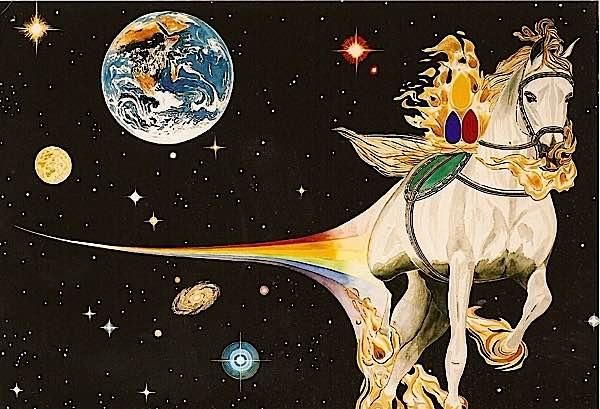
The Tibetan Windhorse is iconic of Lung or wind (Chi, Prana or breath). The Windhorse symbolically carries the prayers and wishes of practitioners to the Universe.
Body mandala
What does all this have to do with Body Mandala? In body mandala meditation, that inner body — the channels and chakras travelled by your consciousness riding lung-ta — is purified and blessed by visualizing your meditation deities and mandala inside your subtle body; in normal “deity generation” meditations we visualize our outer body as the Enlightened deity. And, of course, by bringing the mind’s focus to the inner body — the channels, chakras, winds (prajna, chi, la) — the mind affects our most subtle inner body.
To paraphrase Hermetic philosophy (Hermes Trismegistus):
“As within, so without.”
[The quote is “That which Below corresponds with that which is Above. And That which Above corresponds with that which is Below.” Often, this is shortened to “As Above, So Below, to accomplish the miracles of the One Thing.”] [2]
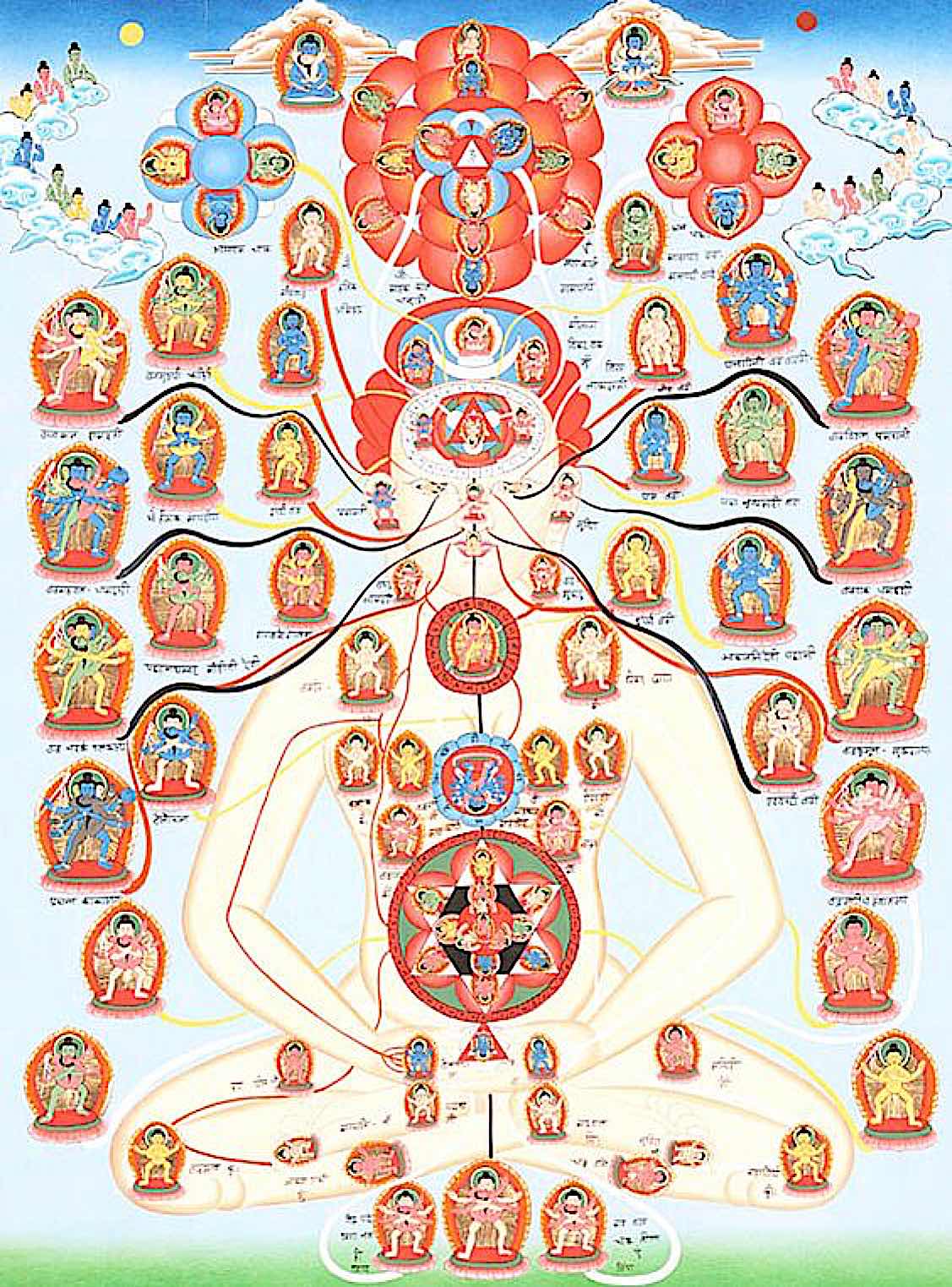
A tantric visualization of body mandala. This practice requires empowerment and a teacher.
Mind and Chi flow where the mind goes
In Tibetan Tantric Buddhism, Indian Tantra and Chinese Medicine — all of which work with inner body — “Chi flows where the mind goes.” In an interesting feature by Paul Crouse, he adds to the thought: so “be careful what you think.” If the mind goes into negative territory, in other words, there goes the chi, la, lifeforce.
Body mandala work in Highest Yoga Tantra is highly secretive, not because of a mystery factor, but simply because it works with the inner body. There are always consequences when the mind “rides the winds” of the inner body — including health and mind benefits, of course.
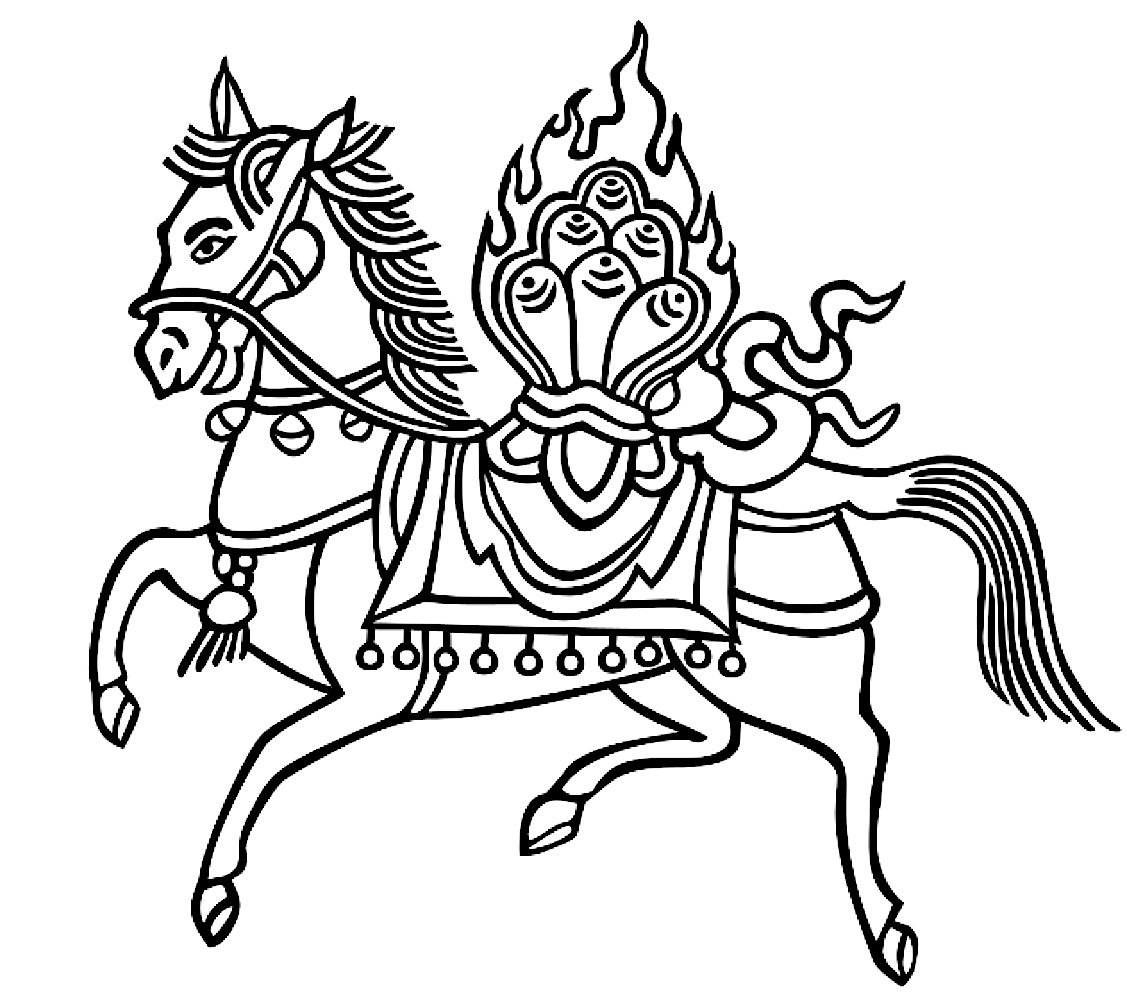
Lungta, or wind horse, as Wish-Fulfilling Horse.
The real goal is always realizations on the path to Enlightenment, but along the way we journey an inner path which has bountiful benefits (including various “Siddhis” or powers.) For all the secrecy, there are things that can be discussed without empowerment or teachings, including the benefits and overall methods.
Somebody mandalas are vastly complex, with a different deity manifesting in the visualization at the end of various meridians in the body. For example, some manifest at our sense meridians: eye, ear, mouth, and so on. Other very profound mandalas visualize all the deities at the heart chakra — notably the most magnificent Vajrayogini body mandala.
All of the formal body mandala practices in Vajrayana Tantric Buddhism do require a teacher (for guidance and safety) — it’s not different in that respect from many advanced physical yogic exercises — and empowerment. Some of the principles could be applied outside of formal practice — as meditative techniques or martial arts techniques. Advanced meditations, such as Completion practices and Body Mandalas absolutely require a teacher and, usually, empowerment for the safety of the student. Why, safety? Remember, “Where the mind goes, the body follows”
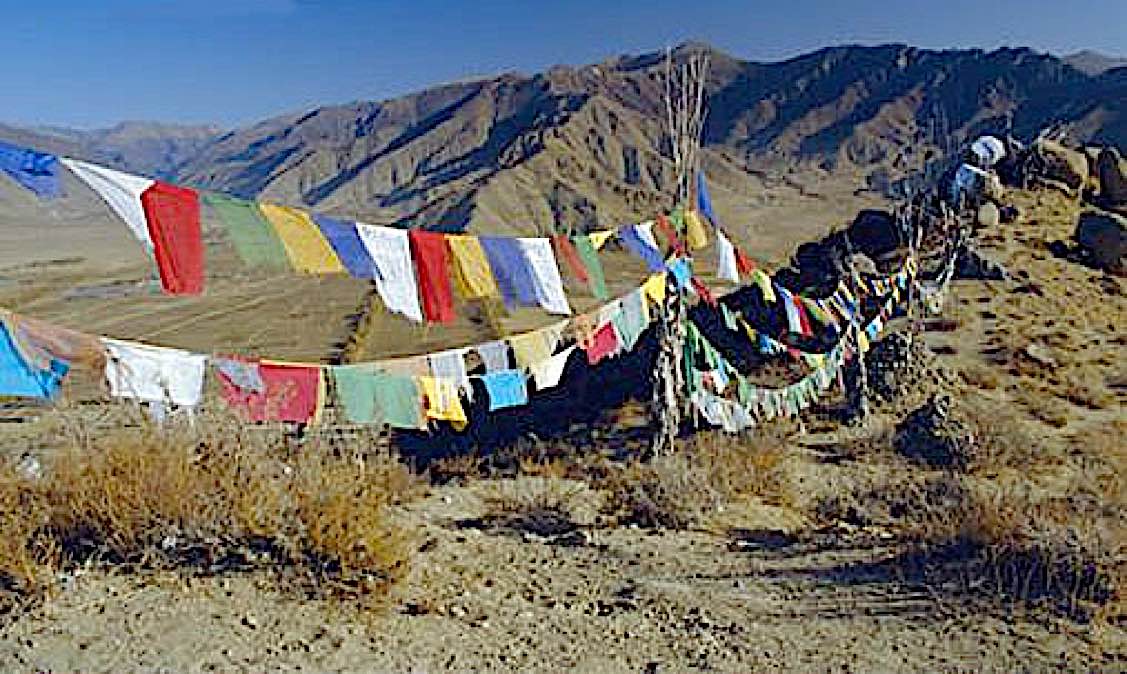
Externalizing the wind horse: prayer flags in the wind carry blessings to sentient beings. The wind horse in the body, is La, Lungta or Chi energy riding on the channels and meridians of the subtle body.
NOTES
[1] The Chi Flows Where the Mind Goes: Be Careful What You Think, by Paul Crouse.
[2] Emerald Tablet of Hermes Trismegistus
[3] Wind Horse article on Wikipedia
[4] “Yantra: The Tantric Symbol of Cosmic Unity” by Madhu Khanna (Thames and Hudson)
This content was originally published here.